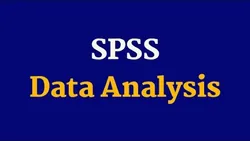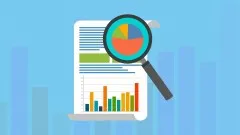
SPSS Tutorial for data analysis SPSS for Beginners Part 2 
This SPSS Tutorial for data analysis SPSS for Beginners Part 2 course provides an in-depth look at the various data analysis techniques available in SPSS. It covers topics such as assessing normality, calculating KR20 reliability coefficient, intra class coefficient, calculating weighted kappa, binary logistic regression, interpreting Pearson's product moment correlation, ANCOVA, bivariate regression, interpreting chi-square, two way anova, multiple logistic regression, Kruskal-wallis one way anova, U-test, multinomial logistic regression, t-test, paired sample t-test, interpreting result of principal components analysis, principal axis factoring, running hierarchical binary logistic regression, and running ordinal regression. This course is suitable for beginners and those with some experience in SPSS. It provides a comprehensive overview of the various data analysis techniques available in SPSS and is an excellent resource for those looking to gain a better understanding of the software. ▼
ADVERTISEMENT
Course Feature
![]() Cost:
Cost:
Free
![]() Provider:
Provider:
Youtube
![]() Certificate:
Certificate:
Paid Certification
![]() Language:
Language:
English
![]() Start Date:
Start Date:
On-Demand
Course Overview
❗The content presented here is sourced directly from Youtube platform. For comprehensive course details, including enrollment information, simply click on the 'Go to class' link on our website.
Updated in [February 21st, 2023]
1. Assessing Normality with SPSS: Learners can obtain the knowledge of how to assess normality with SPSS. This includes understanding the concept of normality, the different tests used to assess normality, and the interpretation of the results. This will help learners to better understand the data they are analyzing and make more informed decisions.
2. Calculating KR20 Reliability Coefficient in SPSS: Learners can learn how to calculate the KR20 reliability coefficient in SPSS. This includes understanding the concept of reliability, the different tests used to calculate the coefficient, and the interpretation of the results. This will help learners to better understand the data they are analyzing and make more informed decisions.
3. Intra Class Coefficient in SPSS: Learners can learn how to calculate the intra class coefficient in SPSS. This includes understanding the concept of intra class correlation, the different tests used to calculate the coefficient, and the interpretation of the results. This will help learners to better understand the data they are analyzing and make more informed decisions.
4. Calculating Weighted Kappa in SPSS: Learners can learn how to calculate the weighted kappa in SPSS. This includes understanding the concept of weighted kappa, the different tests used to calculate the coefficient, and the interpretation of the results. This will help learners to better understand the data they are analyzing and make more informed decisions.
5. Binary Logistic Regression in SPSS: Learners can learn how to perform binary logistic regression in SPSS. This includes understanding the concept of logistic regression, the different tests used to perform the regression, and the interpretation of the results. This will help learners to better understand the data they are analyzing and make more informed decisions.
[Applications]
After completing this course, participants can apply the knowledge they have gained to analyze data using SPSS. They can use the techniques they have learned to assess normality, calculate reliability coefficients, intra class coefficients, weighted kappa, binary logistic regression, Pearson's product moment correlation, ANCOVA, bivariate regression, chi-square, two way ANOVA, multiple logistic regression, Kruskal-wallis one way ANOVA, U-test, multinomial logistic regression, t-test, paired sample t-test, principal components analysis, principal axis factoring, hierarchical binary logistic regression, and ordinal regression.
[Career Paths]
1. Data Analyst: Data Analysts use SPSS to analyze data and create reports to help organizations make informed decisions. They use SPSS to identify trends, patterns, and correlations in data sets, and to develop predictive models. The demand for Data Analysts is increasing as organizations become more data-driven and need to make decisions based on data.
2. Market Research Analyst: Market Research Analysts use SPSS to analyze data from surveys and other sources to identify customer needs and preferences. They use SPSS to develop marketing strategies and campaigns, and to measure the effectiveness of those strategies. The demand for Market Research Analysts is increasing as organizations look to better understand their customers and target their marketing efforts.
3. Business Intelligence Analyst: Business Intelligence Analysts use SPSS to analyze data from multiple sources and create reports to help organizations make better decisions. They use SPSS to identify trends, patterns, and correlations in data sets, and to develop predictive models. The demand for Business Intelligence Analysts is increasing as organizations become more data-driven and need to make decisions based on data.
4. Data Scientist: Data Scientists use SPSS to analyze data from multiple sources and create reports to help organizations make better decisions. They use SPSS to identify trends, patterns, and correlations in data sets, and to develop predictive models. The demand for Data Scientists is increasing as organizations become more data-driven and need to make decisions based on data.
[Education Paths]
1. Bachelor of Science in Statistics: This degree program provides students with a comprehensive understanding of statistical methods and techniques, including data analysis, probability, and sampling. Students learn to apply these methods to real-world problems and develop the skills to interpret and communicate the results. The degree also covers topics such as data mining, machine learning, and predictive analytics, which are becoming increasingly important in the modern world.
2. Master of Science in Data Science: This degree program focuses on the application of data science techniques to solve complex problems. Students learn to use data to identify patterns, develop models, and make predictions. They also gain an understanding of the ethical implications of data science and the importance of data privacy. This degree is ideal for those who want to pursue a career in data science or analytics.
3. Doctor of Philosophy in Applied Statistics: This degree program provides students with an in-depth understanding of statistical methods and their application to real-world problems. Students learn to develop and apply statistical models to solve complex problems and gain an understanding of the ethical implications of data analysis. This degree is ideal for those who want to pursue a career in research or academia.
4. Master of Science in Business Analytics: This degree program focuses on the application of data analytics to business problems. Students learn to use data to identify trends, develop strategies, and make decisions. They also gain an understanding of the ethical implications of data analysis and the importance of data privacy. This degree is ideal for those who want to pursue a career in business analytics or data-driven decision making.
Course Provider

Provider Youtube's Stats at AZClass
Discussion and Reviews
0.0 (Based on 0 reviews)
Explore Similar Online Courses

Speaking to a Technical Group

Learn How to Get Your First Million Users

Python for Informatics: Exploring Information

Social Network Analysis

Introduction to Systematic Review and Meta-Analysis

The Analytics Edge

DCO042 - Python For Informatics

Causal Diagrams: Draw Your Assumptions Before Your Conclusions

Whole genome sequencing of bacterial genomes - tools and applications

Non-Parametric Analysis

SPSS Masterclass: Learn SPSS From Scratch to Advanced


Start your review of SPSS Tutorial for data analysis SPSS for Beginners Part 2